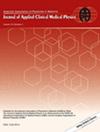A systematic review of electron FLASH dosimetry and beam control mechanisms utilized with modified non-clinical LINACs
Abstract
Background
FLASH has been shown to spare normal tissue toxicity while maintaining tumor control. However, existing irradiation platforms and dosimetry are not compatible. Consequently, an abundance of FLASH delivery devices and new dosimetry across all modalities has been created. Many review articles concluded that dosimetry is modality-dependent. Focusing on electrons, researchers have modified clinical LINACs to enable FLASH dose rates. Modified LINACs caused the development of unique control systems that have yet to be characterized. Improvement could be made when considering the organization of reviews.
Purpose
To systematically perform a literature survey on electron FLASH dosimetry and beam control mechanisms with modified LINACs, detail where articles originated, and organize the results.
Methods
A literature survey was performed from two websites using specified keywords and sifted results to find articles that fit the criteria. The results were organized in tables and summaries effectively by matching up dosimeters with their measurement goal, referring to their specific models, outlining the irradiation conditions they were tested in, and detailing their calibration procedure. Furthermore, included was the unique topic of control mechanisms.
Results
Twenty-eight matches were found. Various dosimeters were examined to measure absorbed dose, beam characteristics (BC), dose per pulse (DPP), and pulse counting (PC). Specific detectors and the irradiation conditions are organized and presented in a table. Each model's pros and cons are presented in another table for further consideration. A third table is provided to detail beam control methods.
Conclusions
Dosimetry is majorly film-based for absorbed dose and beam characteristic measurements. Many candidates for dosimeters for the use of DPP and PC have been tested, but they have yet to be tested without limitations. Beam control mechanisms primarily consist of unacceptable delivery errors. Many suggestions for improvement were given, mainly consisting of finding new dosimeters and modulating the dose DPP.


 求助内容:
求助内容: 应助结果提醒方式:
应助结果提醒方式:


